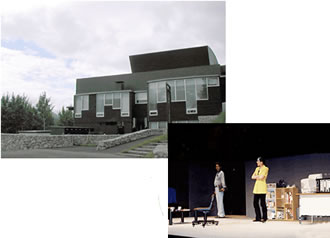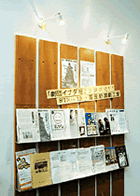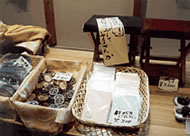Vol.9
Sound System for "Furano Engeki Kojo" Hall in Furano, Hokkaido
- A drama factory reaches out to people through ripples of inspiration -
Sound System for "Furano Engeki Kojo" Hall in Furano, Hokkaido

Dramas are the products made at this little factory in a northern island.
Creating,learning,acting,seeing,
experiencing.
Vibrations produced by the people here fill the hall and spread out to the town and the world.
The opportunity first arose when playwright So Kuramoto began his creative activities in Hokkaido. The success of "Kita no kuni kara," (From a northern island), the serialized television drama which began in 1981 and continues today to keep up to date with the lives of its characters, made the town of Furano famous. The factory appeared some 20 years after the serial first began, at the eager request of the people of the town. It creates "dramas" based on the nature of Furano and the people who live in this natural environment. Vibrations from those who take part, acting, watching, and supporting, are amplified in the factory and spread out to inspire others.

The theater has a seating capacity of 300 and high-priced tickets are not allowed. Virtually every well-known actor or actress who has visited the theater has said
"I want to act on that stage."
Talented stage performers no doubt can sense the thoughts of the local audience enclosed in this tiny theater, loving the culture of the theater, and proud that it is part of their town.
As the name "Furano Engeki Kojo" ("Kojo" means "Factory) suggests, the theater is a factory and its products are dramas which have been ripened in the fertile soil of Furano.

The theater is managed by a theater group, a special non-profit organization made up of volunteers from the region. At present it is said that there are over 4000 bodies which have been officially approved as NPOs in Japan; this group received such approval first in Japan. Their diligent and sincere activities have been widely recognized and their success is the fruit of many years of steady and persistent efforts.

The theater, built against a background of mountains with dazzling green trees, is a simple building of black wood and glass. At the entrance is a list of the names of those who have been involved in its establishment, with no company names or titles. The handbills showing forthcoming attractions give equal space to plays crafted by local people, popular dramas by graduates of Kuramoto's Furanojuku Theater Workshop, and the faces of actors and actresses familiar from television and film. This is because everyone who steps onto the factory stage brings the same passion to the creation of theatrical culture.
The lobby, lit by daylight pouring through the glass, is a community area where local people can meet freely or enjoy a drink and a chat about the performance afterwards. There is even a soundproof playroom from which parents accompanied by children can see the stage.
The sound and lighting systems can be adapted at will to suit a wide range of productions. With a depth of 14 meters, the stage imposes no limits on performance possibilities.
The unique character of this theater, enjoyed to the full by players and audience alike, is also displayed behind the scenes. The greenroom, rehearsal room, work area, and dressing room are exceptionally spacious for a small theater and there are also ample office facilities for the volunteers involved in management.

This is not simply a performance hall. Elderly people are encouraged to help make theatrical sets as a form of physiotherapy; children's workshops are held; and it is not rare to find volunteers guiding cars to the theater in temperatures of minus 30 degrees Centigrade. Bouncing off each other, the ideas of people with vision, who take pride in what they do, are amplified across distances to inspire others from this factory of passion and excitement.